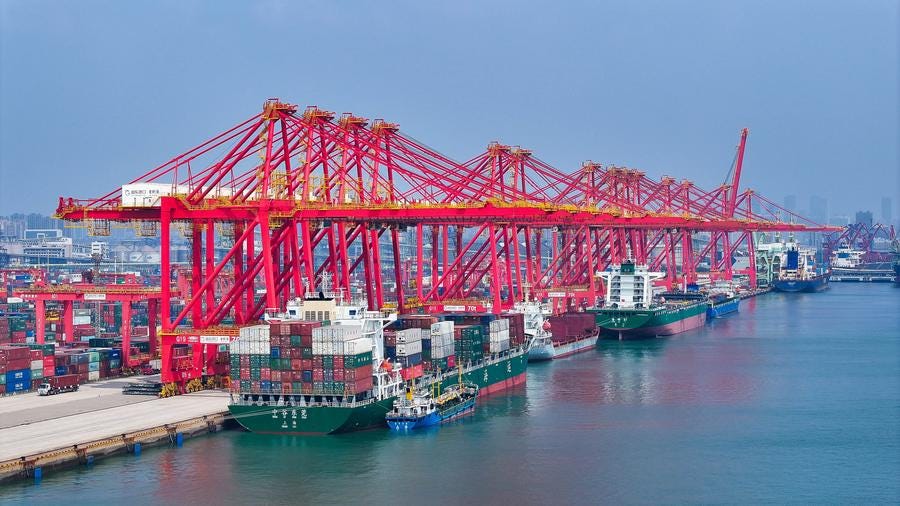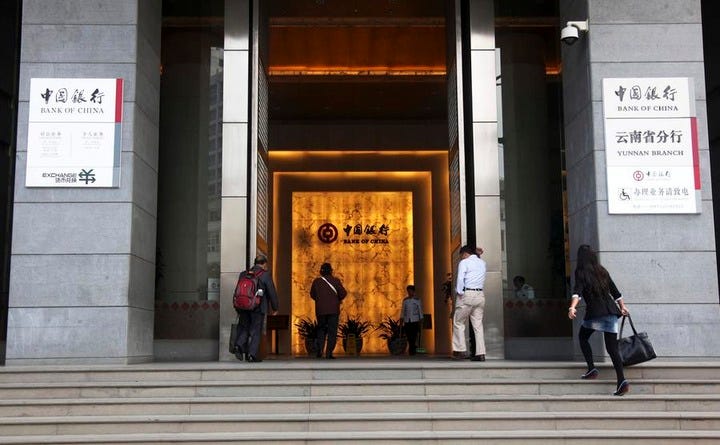Delving into China's sweeping financial policy package
A new round of financial stimulus has been unveiled in China to shore up the economy. What does this latest policy move signal for the broader economy, and what measures are likely to follow?
China's financial regulators rolled out a new package of measures last week, including cuts to interest rates and the reserve requirement ratio (RRR), alongside stepped-up support for consumption, innovation and key industries, marking a renewed effort to stabilize markets and strengthen growth momentum.
Some of the announced measures have already kicked in, including the RRR reduction effective Thursday that will inject roughly 1 trillion yuan (about 139 billion U.S. dollars) of long-term liquidity into the financial market.
In this edition, Peking Ensight reviews analysis from three research institutions on the newly introduced policy package, examining why it was launched at this moment, how it fits into the broader economic picture, what characterizes this round of measures, and what future policy directions might look like.
What Prompts Policy Push
Unveiled at a joint press conference held by the heads of the People’s Bank of China, the National Financial Regulatory Administration, and the China Securities Regulatory Commission, the package closely followed the late-April meeting of the Political Bureau of the Communist Party of China Central Committee.
The meeting assessed the current economic situation and called for accelerated implementation of more proactive and effective macroeconomic policies, in what analysts view as both strategic and tactical responses to China's economic challenges, particularly in the face of escalating tariff tensions.
The rollout of the package comes at a pivotal moment, as China faces growing internal and external pressures, said China Minsheng Bank in a report. The package is aimed at restoring market confidence, encouraging participation from market players, and stabilizing credit conditions.
It also reinforces the sustainability of financial support for the real economy. According to China Minsheng Bank's report, the package reflects China's commitment to stronger macro policy coordination and its determination to meet full-year growth targets.
China's economy started 2025 on a solid footing, with gross domestic product expanding 5.4 percent year on year in the first quarter, official data showed. But pressure remained, as the manufacturing purchasing managers' index dropped to 49 in April, falling below the 50-point mark that separates expansion from contraction.
The late-April Political Bureau meeting said China has seen its economy improve this year. Meanwhile, it cautioned that the foundation for the country's sustained economic recovery needs to be further consolidated, and the country faces increasing impact from external shocks. The meeting urged preparing for worst-case scenarios with sufficient planning.
Inside New Policy Package
The latest financial policy package arrived as expected and offered targeted remedies to current economic challenges, combining immediate supportive monetary measures with longer-term institutional reforms, said Guosheng Securities in a report.
China Minsheng Bank highlighted in the report that the central bank adopted a multipronged approach, addressing three key areas: the quantity, price and structure of monetary policy.
This coordinated strategy is aimed at lowering banks’ funding costs, boosting effective credit demand, and supporting continued recovery in the real economy. At the same time, it helps maintain stable net interest margins and advances the evolution of China’s monetary policy framework.
A defining feature of this package is its swift rollout. The interest rate cut took effect on May 8, just one day after the announcement, with the RRR cut following on May 15, China Minsheng Bank added.
A Yuekai Securities report examines the impact and implications of the latest financial policy package in five aspects.
Stabilizing the Property Market
The reduction in the RRR and interest rates eases mortgage repayment pressure on households, boosting home-buying sentiment and helping to halt the decline in the property market. Lower funding costs for commercial banks also enhance their lending capacity, enabling stronger support for the real economy.
Supporting Capital Markets
A series of concrete measures were introduced to stabilize and invigorate China’s capital markets, including sustained efforts to guide more medium- and long-term capital into the market, and improvements to capital market infrastructure and regulations.
The central bank has also pledged strong support for Central Huijin to act as a stabilization fund, including potential purchases of stock index funds when necessary. This sends a clear signal to the market, helping boost investor confidence, raise risk appetite and stabilize expectations.
Boosting Service Consumption
A 500-billion-yuan(70-billion-USD)re-lending facility has been launched to support service consumption and elderly care. With services now accounting for more than half of total household consumption, the move aims to unlock demand in key growth areas such as culture, tourism, entertainment, elderly care, and healthcare.
Advancing Technological Innovation
As China enters a pivotal phase of transitioning from old growth drivers to new engines of productivity, the financial package also gives much weight to technological innovation. A dedicated "technology board" is being set up in the bond market to facilitate the issuance of tech innovation bonds. The scale of re-lending for tech innovation will also be expanded. Combined with increased fiscal investment in R&D, these measures aim to break bottlenecks in core technologies, improve supply-side capacity, and achieve a better supply-demand balance.
Assisting Tariff-Affected Firms
Banks and insurers will provide stronger financial and insurance support to companies hit by tariff-related shocks. Regulatory oversight of listed firms, particularly on equity pledges, will be made more flexible. These efforts are intended to safeguard employment, stabilize business operations and support companies under strain.
What Comes Next
Following the release of the financial package, markets responded positively, according to China Minsheng Bank. Short-term bond yields edged down slightly while long-term yields rose modestly. The A-share market saw broad gains, and the RMB exchange rate remained stable.
The policies have already helped boost market confidence and anchor expectations. The policy mix will be key to sustaining financial support for the real economy and achieving China’s full-year growth targets, China Minsheng Bank added.
Guosheng Securities noted that more incremental policies are likely to follow, with a focus on fiscal expansion, boosting domestic demand, and stabilizing foreign trade.
Possible measures include increased government spending, new issuances of treasury or special-purpose bonds, and expanded investment in equipment upgrades, consumer goods trade-ins, key infrastructure projects, service consumption, and urban renewal initiatives.
China Minsheng Bank noted that if internal and external conditions require, and policy space continues to widen, additional tools are likely to be introduced in phases. These measures aim to deliver greater policy certainty and support high-quality development amid rising global uncertainties.
Further monetary easing is also anticipated. China Minsheng Bank expects another 50-basis-point cut to the reserve requirement ratio (RRR) within the year, which would inject more medium- and long-term liquidity into the financial system.
Additional tools such as targeted re-lending for foreign trade and policy-based financial instruments are also anticipated. These would support exporters and their supply chains, while complementing fiscal efforts to stabilize trade and stimulate infrastructure investment.
The National Financial Regulatory Administration said it will accelerate the development of financing mechanisms aligned with China’s evolving real estate model. This includes refining loan management rules for property development, personal housing, and urban renewal.
Financial institutions will be guided to maintain stable real estate financing, better meet both rigid and improvement-oriented housing demand, and strengthen funding support for high-quality housing, contributing to the ongoing stabilization of the property market.
Compiled by Q. Han














